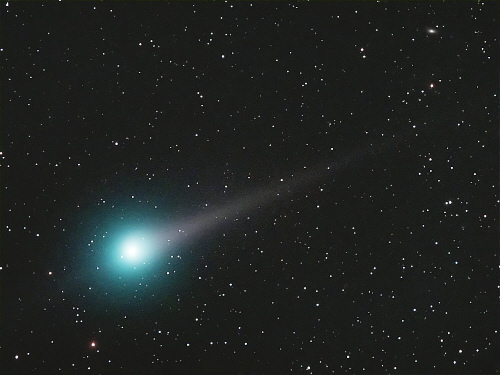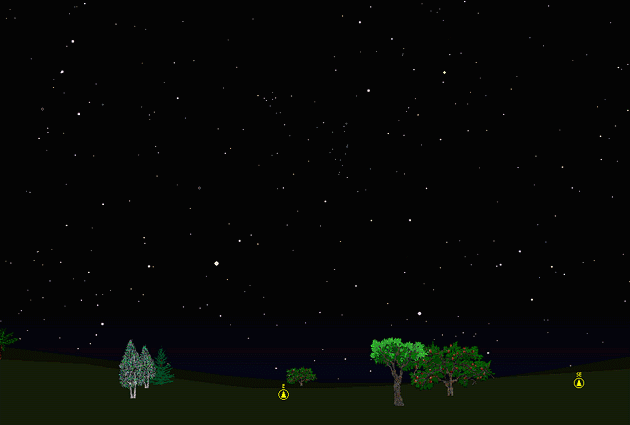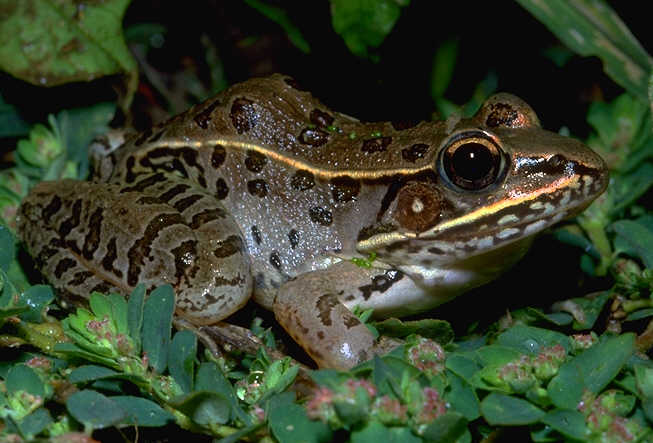The purpose of this feature is to give scout leaders, educators and naturalists an idea of some of the natural events coming up each month. We will try to cover a variety of natural events ranging from sky events to calling periods of amphibians, bird and mammal watching tips, prominent wildflowers and anything else that comes to mind. We will also note prominent constellations appearing over the eastern horizon at mid-evening each month for our area for those who would like to learn the constellations. If you have suggestions for other types of natural information you would like to see added to this calendar, let us know! Note: You can click on the hyperlinks to learn more about some of the featured items. To return to the Calendar, hit the "back" button on your browser, NOT the "back" button on the web page. All charts are available in a "printer friendly" mode, with black stars on a white background. Left clicking on each chart will take you to a printable black and white image.
Notes and Images From February 2009 We've had some interesting visitors this winter. Our notes from January featured a Snowy Owl that came from the northern tier of states. Last month's visitor came from much farther away. Comet Lulin was an easy binocular object in February, and could just be seen with the naked eye in dark skies. The gas, or ion, tail of the comet extends a short distance down and to the left in the adjacent image. We were not able to see the gas tail in binoculars. The more prominent dust tail, extending upward and to the right, was faintly visible in 10x50 binoculars. The human eye is not very good at detecting color at low light levels, and visually the comet appeared without color. The plane of this comet's orbit around the Sun is almost identical to the plane of the Earth's orbit. Since most of the material in a comet's tail is confined to the plane of its orbit, the comet's dust tail looks very thin from our perspective. Comets are essentially "dirty icebergs," composed of interstellar dust and ice, and are thought to form a spherical shell around the Sun. This shell, called the Oort Cloud, extends outward to an astounding 50,000 astronomical units (one astronomical unit is the distance from the Earth to the Sun), or about one quarter of the distance from the Sun to its nearest stellar neighbor. In the book, Comet, Carl Sagan and Ann Druyan wrote about the icy inhabitants of the Oort Cloud;
Occasionally the gravitational influence of a passing star disturbs the Oort Cloud and sends a comet on a long journey towards our Sun. Although some comets are snared into shorter-period orbits by the gravitational pull of the planets, Comet Lulin will head back into the cold and ancient realm from which it came, not returning for over 1000 years. For more on Comet Lulin, including a higher resolution image, click on the image above.
Sky Events for March 2009: The Vernal Equinox, marking the beginning of spring in the Northern Hemisphere, occurs on March 22nd at 6:44am CDT. Evening Sky: Comet Lulin is fading now, and it moves from Leo into Cancer at the beginning of March. It is best to use binoculars, and the comet appears as a dim patch of light. Moonlight will tend to interfere with observations from March 1st through March 11th. For finder charts, click here. Venus will continue to sink lower into the twilight as March progresses. Venus will reach inferior conjunction on March 27th, passing between Earth and the Sun. Venus will approach the Earth to within about 26 million miles, which gives you the chance to see a beautiful thin crescent phase using only a steadily supported pair of binoculars. Be sure and find Venus as soon as you can after sunset. If you are using binoculars, be sure that the Sun has set - you can permanently damage your eyes if you sweep across the Sun while searching for Venus. If you wait till the sky is dark, you will not be able to see the crescent phase well. Sometimes there are thin clouds near the horizon, and the view of the tiny crescent planet against a twilight cloudscape is unforgettable. Saturn rises due east at dusk at the beginning of March. You will want to wait till it has risen high into the sky to get the best telescopic views. The rings are almost edge-on, tilted between two and three degrees. Morning Sky: Jupiter is visible in the dawn sky before sunrise in March, gradually climbing higher above the horizon as the month progresses.
Constellations: The views below show the sky looking east at 9:00pm CST on March 15th. The first view shows the sky with the constellation outlines and names depicted. Star and planet names are in yellow. Constellation names are in green. The second view shows the same scene without labels. The bright star Arcturus, in Bootes, the Herdsman, makes its appearance this month in the early evening sky, a sure sign that Spring is here. Below Bootes is Corona Borealis, the Northern Crown. In the southeast, Virgo clears the horizon this month along with Corvus, the Crow.
On Learning the Constellations: We advise learning a few constellations each month, and then following them through the seasons. Once you associate a particular constellation coming over the eastern horizon at a certain time of year, you may start thinking about it like an old friend, looking forward to its arrival each season. The stars in the evening scene above, for instance, will always be in the same place relative to the horizon at the same time and date each March. Of course, the planets do move slowly through the constellations, but with practice you will learn to identify them from their appearance. In particular, learn the brightest stars (Like Arcturus and Denebola in the above scene looking east), for they will guide you to the fainter stars. Once you can locate the more prominent constellations, you can "branch out" to other constellations around them. It may take you a little while to get a sense of scale, to translate what you see on the computer screen or what you see on the page of a book to what you see in the sky. Look for patterns, like the stars of Corvus the Crow. The earth's rotation causes the constellations to appear to move across the sky just as the sun and the moon appear to do. If you go outside earlier than the time shown on the charts, the constellations will be lower to the eastern horizon. If you observe later, they will have climbed higher. As each season progresses, the earth's motion around the sun causes the constellations to appear a little farther towards the west each night for any given time of night. The westward motion of the constellations is equivalent to two hours per month. Recommended: Sky Publishing has a beautiful and compact star atlas, the Sky & Telescope's Pocket Star Atlas. It is destined to become a classic, and is a joy to use at the telescope. A good book to learn the constellations is Patterns in the Sky, by Hewitt-White. You may also want to check out at H. A. Rey's classic, The Stars, A New Way to See Them. For skywatching tips, an inexpensive good guide is Secrets of Stargazing, by Becky Ramotowski. A good general reference book on astronomy is the Peterson
Field Guide,
A Field Guide to the Stars and Planets, by Pasachoff. The book retails for around $14.00. Starry Night has several software programs for learning the night sky. Visit the Starry Night web site at www.starrynight.com for details.
Amphibians:
We have already heard Southern Leopard Frogs, Upland Chorus Frogs and Spring Peepers calling this year. Listen for American Toads to begin calling in March. In West Tennessee, Crawfish Frogs continue to give their loud snoring calls early in the month. At higher elevations, listen for Mountain Chorus Frogs. Towards the end of the month listen for Pickerel Frogs doing their "yeeooow" call. Remember that on mild nights you may find frogs and toads out foraging that you do not hear until later in the season. On warm days listen for early treefrogs, like Cope's Gray Treefrog, and for early Northern Cricket Frogs.
Birds:
This time of year is prime time to find owl nests. Since the leaves have not yet appeared on most trees, you can sometimes spot the old stick nests that the owls often use for nesting. Observe only at a distance and do not try to approach a nest, both for your own safety and to keep from flushing the owl off the eggs. The adult's absence, if it flushes, can allow the eggs to rapidly get too cold, and may doom the nest. Look and listen for the young Great Horned Owls. If you find a young owl on the ground, leave it there! Its parents will feed it on the ground. Well-meaning people sometimes take young owls they find on the ground to wildlife rehabilitation centers, thinking the young owls have been abandoned. This is not necessary, and it may prevent the owl from ever successfully living in the wild. Don't do it. Recommended: Bird Finding in Tennessee, Michael Lee Bierly. A classic guide to finding birds in Tennessee. The Sibley Guide to Birds, David Allen Sibley The Sibley Guide to Birds of Eastern North America, David Allen Sibley This new Sibley Guide covers only eastern North America, is quite compact, and is less expensive than the larger Sibley. An inexpensive guide for beginners is the Golden Guide for Birds.
Archives (Remember to use the back button on your browser, NOT the back button on the web page!) Natural Calendar February 2009 Natural Calendar December 2008 Natural Calendar November 2008 Natural Calendar September 2008 Natural Calendar February 2008 Natural Calendar December 2007 Natural Calendar November 2007 Natural Calendar September 2007 Natural Calendar February 2007 Natural Calendar December 2006 Natural Calendar November 2006 Natural Calendar September 2006 Natural Calendar February 2006
Natural Calendar
December 2005
Natural Calendar
November 2005
Natural Calendar
September 2005
Natural Calendar
February 2005
Natural Calendar
December 2004
Natural Calendar
November 2004
Natural Calendar
September 2004
Natural Calendar
February 2004
Natural Calendar
December 2003
Natural Calendar
November 2003
Natural Calendar
September 2003 Natural Calendar February 2003 Natural Calendar December 2002 Natural Calendar November 2002 Nature Notes Archives: Nature Notes was a page we published in 2001 and 2002 containing our observations about everything from the northern lights display of November 2001 to frog and salamander egg masses. Night scenes prepared with Starry Night Pro software All images and recordings © 2009 Leaps |




